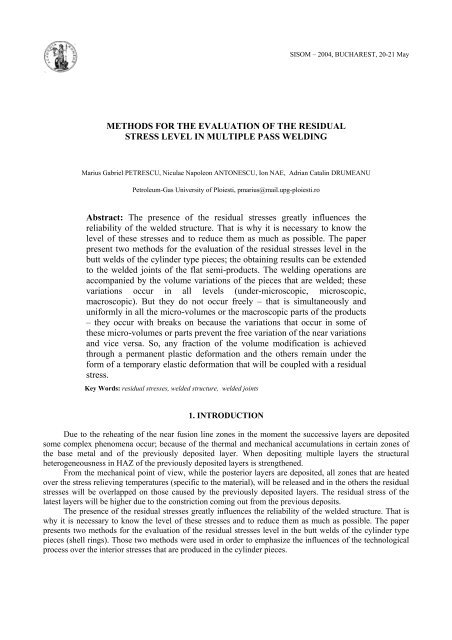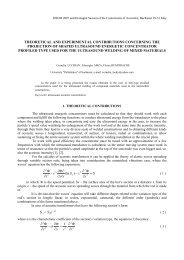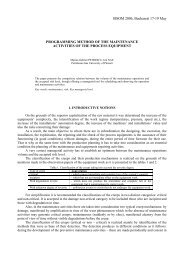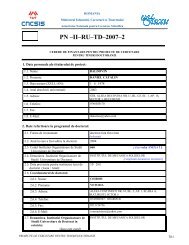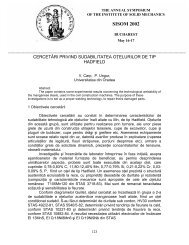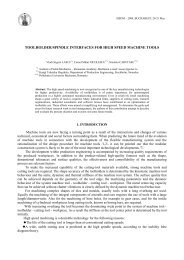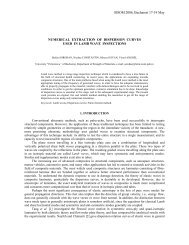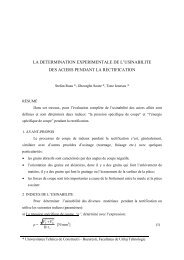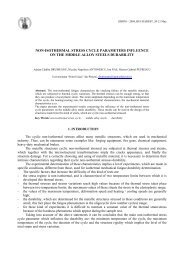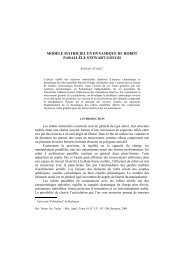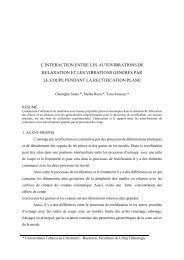THE EFFECT OF HEAT TREATMENTS ON THE BEHAVIOR
THE EFFECT OF HEAT TREATMENTS ON THE BEHAVIOR
THE EFFECT OF HEAT TREATMENTS ON THE BEHAVIOR
Create successful ePaper yourself
Turn your PDF publications into a flip-book with our unique Google optimized e-Paper software.
SISOM – 2004, BUCHAREST, 20-21 May<br />
METHODS FOR <strong>THE</strong> EVALUATI<strong>ON</strong> <strong>OF</strong> <strong>THE</strong> RESIDUAL<br />
STRESS LEVEL IN MULTIPLE PASS WELDING<br />
Marius Gabriel PETRESCU, Niculae Napoleon ANT<strong>ON</strong>ESCU, Ion NAE, Adrian Catalin DRUMEANU<br />
Petroleum-Gas University of Ploiesti, pmarius@mail.upg-ploiesti.ro<br />
Abstract: The presence of the residual stresses greatly influences the<br />
reliability of the welded structure. That is why it is necessary to know the<br />
level of these stresses and to reduce them as much as possible. The paper<br />
present two methods for the evaluation of the residual stresses level in the<br />
butt welds of the cylinder type pieces; the obtaining results can be extended<br />
to the welded joints of the flat semi-products. The welding operations are<br />
accompanied by the volume variations of the pieces that are welded; these<br />
variations occur in all levels (under-microscopic, microscopic,<br />
macroscopic). But they do not occur freely – that is simultaneously and<br />
uniformly in all the micro-volumes or the macroscopic parts of the products<br />
– they occur with breaks on because the variations that occur in some of<br />
these micro-volumes or parts prevent the free variation of the near variations<br />
and vice versa. So, any fraction of the volume modification is achieved<br />
through a permanent plastic deformation and the others remain under the<br />
form of a temporary elastic deformation that will be coupled with a residual<br />
stress.<br />
Key Words: residual stresses, welded structure, welded joints<br />
1. INTRODUCTI<strong>ON</strong><br />
Due to the reheating of the near fusion line zones in the moment the successive layers are deposited<br />
some complex phenomena occur; because of the thermal and mechanical accumulations in certain zones of<br />
the base metal and of the previously deposited layer. When depositing multiple layers the structural<br />
heterogeneousness in HAZ of the previously deposited layers is strengthened.<br />
From the mechanical point of view, while the posterior layers are deposited, all zones that are heated<br />
over the stress relieving temperatures (specific to the material), will be released and in the others the residual<br />
stresses will be overlapped on those caused by the previously deposited layers. The residual stress of the<br />
latest layers will be higher due to the constriction coming out from the previous deposits.<br />
The presence of the residual stresses greatly influences the reliability of the welded structure. That is<br />
why it is necessary to know the level of these stresses and to reduce them as much as possible. The paper<br />
presents two methods for the evaluation of the residual stresses level in the butt welds of the cylinder type<br />
pieces (shell rings). Those two methods were used in order to emphasize the influences of the technological<br />
process over the interior stresses that are produced in the cylinder pieces.
Marius Gabriel PETRESCU, Niculae Napoleon ANT<strong>ON</strong>ESCU, Ion NAE, Adrian Catalin DRUMEANU 372<br />
2. METHODS<br />
The paper [2] presents the Sachs method for the calculation of the residual stresses occurring in the<br />
annular section cylinder type pieces. In order to determine the tangential residual stress a longitudinal section<br />
is made in the shell ring measuring its exterior diameter perpendicularly to the section before (D 0 in mm)<br />
and after (D 1 in mm) cutting (figure 1).<br />
Figure 1. Sectional ring (Sachs method)<br />
Figure 2. The turning off method.<br />
In order to express the maximal value of the tangential remanent stress according to the exterior fibre<br />
of the shell ring, in the paper [3] there is proposed the following calculation relation:<br />
σ =<br />
1<br />
E<br />
2<br />
−µ ⋅s⋅ ( D0 D1<br />
1 1<br />
− ) [N/mm 2 ] (1)<br />
where: s is the the thickness of the shell ring, in mm; E – the longitudinal elasticity module, in N/mm 2<br />
(for steel E = 2,1 * 10 5 N/mm 2 ); µ - the Poisson coefficient (for steel µ = 0,3).
373<br />
Methods for the evaluation of the residual stress level in multiple pass welding<br />
The second method (the turning method) consists in cutting a number of rings out of the same sample.<br />
One of these will remain complete and the others will be turned off, the thickness of the material (t) which is<br />
turned off (differs to each ring) either from the exterior of the ring or from the interior (figure 2). The steel<br />
ring realized is cut in a total opposite point to the point in which is calculated the value of the σ stress. For<br />
each case σ is calculated using the relation (1) and taking into account that the obtained value which is<br />
obtained value of the residual stress at the distance t from the surface of the shell ring (when the interior<br />
turning occurs the sign of σ is changed, as the relation (1) gives the values for the exterior fibre, the values<br />
for the interior fibre are supposed to be equal in module and of opposite sign).<br />
3. EXPERIMENTAL RESEARCH<br />
For the study there was used a steel sheet semi-product R 510 – STAS 2883/2-91 having the thickness<br />
s = 12 mm, from which there were made by rolling and longitudinal welding, 3 shell rings having the form<br />
and the dimensions presented in figure 3.<br />
For the longitudinal welding there was used the procedure SE: covered electrodes Nibaz 65 having the<br />
diameter of 2,5 and respectively 3,25 mm; I S = 120 A; U a = 24 V; E L = 15000 … 17000 J/cm. The welded<br />
joint was realized by keeping to the succession of the stages presented in the figure 3.<br />
Figure 3. The shell rings for the study<br />
The second shell ring was submitted to a thermal stress relieving treatment (t î = 580 0 C; τ m = 90 min)<br />
and the third shell ring was submitted to a new rolling (calibration).<br />
From those produced shell rings there were assayed rings with the width of h = 20 mm.<br />
In order to establish the maximal values of the stresses from the shell rings in the 3 variants of<br />
preparation, three rings of each sample were cut in a total opposite diametric point of the welded joint using<br />
a face and side cutter having the width of 2 mm. The measuring results (according to the methodology<br />
already presented), as average of the three values are presented in the table 1 (rings no. 1 of the samples 1, 2<br />
and 3).<br />
In order to establish the distribution of the stresses on the thickness of the 3 samples there was applied<br />
the turning method. The results are presented in the table 1 and in the figures 4, 5 and 6.
Marius Gabriel PETRESCU, Niculae Napoleon ANT<strong>ON</strong>ESCU, Ion NAE, Adrian Catalin DRUMEANU 374<br />
4. C<strong>ON</strong>CLUSI<strong>ON</strong>S<br />
Analyzing the results of the research presented at this point the following may be concluded:<br />
- when using the multiple pass welding of the steels, the successive layer deposition of filler<br />
material has favorable effects on the level of the residual stresses in the welded joint the level of<br />
the residual stresses goes down). This phenomenon is explained through the reannealing effect<br />
produced by the layers which are deposited over the previously deposited layer;<br />
Table 1. The distribution of the stresses on the thickness of the samples<br />
No.<br />
1<br />
2<br />
Sample characteristics<br />
Welded / without stress<br />
relieving<br />
Welded / Stress<br />
relieved<br />
3 Welded / re-rolled<br />
Ring Type of turning off<br />
σ ext / int<br />
D<br />
no. and t values, mm<br />
0 mm D 1 mm t<br />
N/mm 2<br />
1 Not turned 250.320 250,752 12 19,0591<br />
2 In the interior t = 2 250,285 250,642 10 -13,1328<br />
3 In the interior t = 4 250,755 250,983 8,1 -9,74577<br />
4 In the interior t = 6 250,452 250,751 6 -0,99157<br />
5 In the exterior t = 2 246,295 246,796 10,2 19,4009<br />
6 In the exterior t = 4 242,312 242,985 8 17,9740<br />
1 Not turned 250,265 250,502 12 10,4687<br />
2 In the interior t = 2 250,273 250,598 10,1 -12,0779<br />
3 In the interior t = 4 250,540 250,762 8 -11,409<br />
4 In the interior t = 6 250,325 250,494 6,2 -3,85616<br />
5 In the exterior t = 2 246,187 246,450 10,3 10,3033<br />
6 In the exterior t = 4 242,281 242,657 8,1 11,9547<br />
1 Not turned 250,292 250,634 12 15,0972<br />
2 In the interior t = 2 250,325 250,615 10,2 -10,8809<br />
3 In the interior t = 4 250,607 250,812 8 -6,02116<br />
4 In the interior t = 6 250,459 250,561 6,1 -0,71761<br />
5 In the exterior t = 2 246,203 246,495 10 11,1034<br />
6 In the exterior t = 4 242,345 242,824 8,1 15,2150<br />
25<br />
20<br />
15<br />
10<br />
sigma, N/mm2<br />
5<br />
0<br />
-5<br />
0 2 4 6 8 10<br />
12<br />
-10<br />
-15<br />
-20<br />
s, mm<br />
Figure 4. The distribution of residual stresses on the thickness of shell ring no. 1.
375<br />
Methods for the evaluation of the residual stress level in multiple pass welding<br />
20<br />
15<br />
10<br />
sigma, N/mm2<br />
5<br />
0<br />
-5<br />
0 2 4 6 8 10<br />
12<br />
-10<br />
-15<br />
-20<br />
s, mm<br />
Figure 5. The distribution of residual stresses on the thickness of shell ring no. 2.<br />
20<br />
15<br />
10<br />
sigma, N/mm2<br />
5<br />
0<br />
-5<br />
0 2 4 6 8 10<br />
12<br />
-10<br />
-15<br />
-20<br />
s, mm<br />
Figure 6. The distribution of residual stresses on the thickness of shell ring no. 3.
Marius Gabriel PETRESCU, Niculae Napoleon ANT<strong>ON</strong>ESCU, Ion NAE, Adrian Catalin DRUMEANU 376<br />
- the stress relieving heat treatment after the welding process has favorable effects; that is the<br />
decreasing of the residual stress level in the welded joint; it can be noticed that in the exterior<br />
fibre, the stress relieving produced stresses having the opposite sing to the residual stresses, of<br />
compression respectively which can have favorable effect during the exploitation, too;<br />
- the application of the rolling has favorable effect (as the stress relieving) on the level of the<br />
remanent stresses due to the welding operation.<br />
REFERENCES<br />
1. ***ASME,1992 – Boiler and Pressure Vessel Code, Section VIII, Division I, American Society of Mechanical Engineers, New<br />
York, NY<br />
2. MOCANU D.R., Experimental analyzing of the stresses, vol II, Editura Tehnica, Bucuresti, 1977.<br />
3. *** Development of High Collapse Casing, HT-95H.S, Nipon Steel Co, Tokyo, June, 1979.<br />
4. PETRESCU M.G., Cercetări privind materialele si tehnologia de executie specifice rezervoarelor sferice pentru produse<br />
petroliere, Ph.D. thesis, Ploiesti, 1997.


